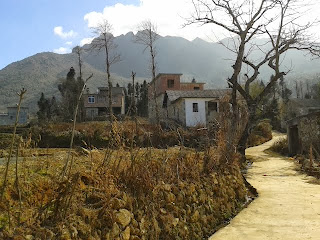I had followed Jacky's directions on my walk, and he said to walk four kilometers along the main road, and then look for a large sign with certain Chinese characters carved on it, on the left side of the road, with a new house next to it, with two old mud houses with thatched roofs across the way. I'd been walking a good while and resigned myself to the fact that I must have missed it somewhere along the way, but at least I'd had a pleasant walk anyhow. I was almost to the point of turning back-maybe it was in that last village?-but ahead I saw one more village, and just before it one of the rustic thatched-roof huts. Alright, alright, one more village and then I'm turning around.
And there it was, just as he'd described. I guess I underestimated how far four kilometers was. He said to follow the dirt road into the village that ran between the sign and the new house.
The village I was staying in seemed awfully far away from modern life to me already, but this... It was like stepping off the road into another century. Jacky has surely given these directions to quite a few people along the way, but it seemed as if this place was untouched by any tourist gawking. This was simply a tribe of people-the Hani-living the way they always had.
Most of the buildings were stuccoed in clay, and covered by thatched roofs. Small rock-wall enclosures alongside the houses penned in grunting pigs and squirming piglets. I saw a couple of pool tables on porches-but they were covered in dust and were being used as more conventional tables, holding up a bundle of firewood or the like.
I wound my way through the alleys of the upper village, which seemed nearly deserted. As Jacky had said, I came out to a round grassy field on a little rise, where a woman in traditional clothing tended long strips of black cloth she was hanging on the line to dry. On the other side of her grassy yard, criss-crossed with dirt tracks like the type that cattle make, the main path continued into the trees and down a steep hill, into a second lower village. This one was even further back in time, far from the sound of cars. I found plenty of people here; five old women, again in traditional colorful headscarves and embroidered skirts, walked in a line up the path, bearing the crop of turnip greens they'd just picked. They smiled at me and were amused at how I was carefully picking my way down the rough stone path that looked slippery to me. They'd walked it every day of their lives; how hard could it be?
 A young pregnant woman and an ancient old man watched me pass curiously from their chairs on a shady front porch. Another old man did a double take to see a foreigner as he rounded a corner with his hoe in his shoulder. I passed three little boys turning over rocks in the stream, looking for salamanders.Children are the same anywhere; two were wearing their rain boots, but the third had kicked his off and rolled up his pants, and was standing ankle-deep in the water. As I was nearly past his mother came out from behind the house and was still fussing at him as I rounded the corner.
A young pregnant woman and an ancient old man watched me pass curiously from their chairs on a shady front porch. Another old man did a double take to see a foreigner as he rounded a corner with his hoe in his shoulder. I passed three little boys turning over rocks in the stream, looking for salamanders.Children are the same anywhere; two were wearing their rain boots, but the third had kicked his off and rolled up his pants, and was standing ankle-deep in the water. As I was nearly past his mother came out from behind the house and was still fussing at him as I rounded the corner. At the bottom of the village I found the rest if the villagers. On a shady stone patio next to one of the village wells, a group of about ten men were gathered around with their knives, cleaning a large pig they'd evidently just butchered that afternoon. About as many women sat or stood around the steps if the house across the way, most with babies tied to their backs with the embroidered maroon slings that the local women all seem to have for the purpose. They were peeling potatoes by rubbing them on rough rocks.

















0 comments:
Post a Comment